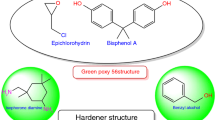Abstract
Traditional method of production of carbon black is very expensive. Recent focus of researchers worldwide is to produce carbon black from agricultural waste products and from some lignocellulosic biomass that is rich in organic materials. In this present study, carbon black is prepared from a biowaste material known as wood apple shell and utilised as reinforcement material in epoxy with filler loading of 5,10,15, and 20 weight percent. Carbon blacks were produced with different carbonisation temperature (400,600 and 800 ℃). Dry sliding wear behaviour of the developed composites was studied. The wear studies with different load and sliding velocities indicate that 10 weight percent of filler loading with carbon black produced with 800 ℃ gives least material removal rate. Surface of wear out composites was studied with FESEM and the dominating wear mechanism was discussed.










Similar content being viewed by others
References
Pierson H O, Handbook of Graphite, diamond, and fullerenes: Properties, Processing and Applications, 1st Edition, 31st December (1994).
Burchell T D, Carbon materials for advanced technologies, 1st Edition, 22nd July (1999).
He Y & Zhang G L, Environmental Pollution, 157 (2009) 2684
Bécu L, Pauline G, Annie C & Sébastien M, Colloids and Surfaces A: Physicochemical and Engineering Aspects, 263 173 (2005).
Li W, Yang K, Peng J, Zhang L, Guo S & Xia H, Ind Crops Prod, 28 192 (2008).
Abdul K, Firoozian P, Bakare I O, Akil H M & Noor A M, Mater Des, 31 3419 (2010).
Ojha S, Acharya S K & Raghavendra G, J Appl Polym Sci, 132 41211 (2015).
Parshetti G K, Kent H S & Balasubramanian R, Bioresour Technol, 135 683 (2013).
Alagumuthu G & Rajan M, Chem Eng J, 158 451 (2010).
Baccar R, Bouzid J, Feki M & Montiel A, J Hazard Mater, 162 1522 (2009).
Luheng W, Tianhuai D & Peng W, Carbon, 47 3151 (2009).
Castro J B, Bonelli P R, Cerrella E G & Cukierman A L, Ind Eng Chem Res, 39 4166 (2000)
Demirbas E, Dizge N, Sulak M T & Kobya M, Chem Eng J, 148 480 (2009).
Xie X, Goodell B, Qian Y, Peterson M & Jellison J, Holzforschung, 62 591 (2008).
Lehmann J and Joseph S, Biochar for environmental management: Science and technology, 1st Edition, 20th February (2015).
Das O, Sarmah A K & Bhattacharyya D, Waste Manag, 38 132 (2015).
Ahmetli G, Kocaman S, Ozaytekin I & Bozkurt P, Polym Compos, 34 500 (2013).
Peterson S C, J Elastomers Plast, 45 487 (2013).
Peterson SC & Kim S, J Polymers and the Environment, 28 317 (2020).
Nan N, DeVallance D B, Xie X & Wang J, J Compos Mater, 50 1161 (2016).
Ojha S, Acharya S K & Gujjala R, Procedia Mater Sci, 6 468 (2014)
Samantrai S P, Raghavendra G, & Acharya S K, Proc. Inst Mech Eng Part J J Eng Tribol, 228 463 (2014).
Prakash M O, Raghavendra G, Ojha S, Wear, 466 203523 (2021).
Ojha S, Acharya S K & Raghavendra G, Proc Inst Mech Eng Part E J Process Mech Eng, 230 263 (2016).
Zahavi J & Schmitt G F, Wear, 71 179 (1981).
Ikram S, Das O & Bhattacharyya D, Compos Part A Appl Sci Manuf, 91 177 (2016).
Bajpai P K, Singh I & Madaan J, Proc Inst Mech Eng Part J J Eng Tribol, 297 829 (2013).
Chauhan S R, Kumar A, Singh I & Kumar P, J Miner Mater Charact Eng, 09 365 (2010)
Author information
Authors and Affiliations
Corresponding author
Additional information
Publisher's Note
Springer Nature remains neutral with regard to jurisdictional claims in published maps and institutional affiliations.
Rights and permissions
About this article
Cite this article
Pradhan, S., Prakash, V., Majhi, S. et al. Dry Sliding Wear Behaviour of Epoxy/Biochar Composites. Trans Indian Inst Met 75, 2355–2365 (2022). https://doi.org/10.1007/s12666-022-02617-2
Received:
Accepted:
Published:
Issue Date:
DOI: https://doi.org/10.1007/s12666-022-02617-2




